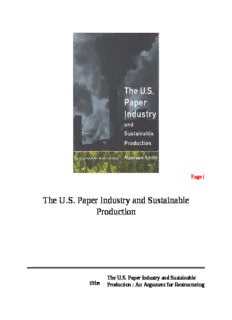
The U.S. paper industry and sustainable production: an argument for restructuring PDF
Preview The U.S. paper industry and sustainable production: an argument for restructuring
Page i The U.S. Paper Industry and Sustainable Production The U.S. Paper Industry and Sustainable title: Production : An Argument for Restructuring Urban and Industrial Environments author: Smith, Maureen. publisher: MIT Press isbn10 | asin: 0262193779 print isbn13: 9780262193771 ebook isbn13: 9780585024448 language: English Paper industry--Government policy--United subject States, Wood-pulp industry--Government policy--United States. publication date: 1997 lcc: HD9826.S65 1997eb ddc: 338.4/5676/0973 Paper industry--Government policy--United subject: States, Wood-pulp industry--Government policy--United States. Page ii Urban and Industrial Environments Series Editor: Professor Robert Gottlieb, School of Public Policy and Social Research, University of California, Los Angeles The U.S. Paper Industry and Sustainable Production: An Argument for Restructuring Maureen Smith, 1997 Page iii The U.S. Paper Industry and Sustainable Production An Argument for Restructuring Maureen Smith The MIT Press Cambridge, Massachusetts London, England Page iv © 1997 Massachusetts Institute of Technology All rights reserved. No part of this book may be reproduced in any form by any electronic or mechanical means (including photocopying, recording, or information storage and retrieval) without permission in writing from the publisher. This book was set in Sabon on the Corel Ventura by Wellington Graphics. Printed and bound in the United States of America. The paper used in this publication is both acid and totally chlorine free (TCF). It meets the minimum requirements of American Standard for Information Sciences-Permanence of Paper for Printed Library Materials, ANSI Z39.481984. Library of Congress Cataloging-in-Publication Data Smith, Maureen, 1956- The U.S. paper industry and sustainable production: an argument for restructuring / Maureen Smith. p. cm. - (Urban and industrial environments) Includes bibliographical references and index. ISBN 0-262-19377-9 (hc: alk. paper) 1. Paper industryGovernment policyUnited States. 2. Wood-pulp industryGovernment policyUnited States. I. Title. II. Series. HD9826.S65 1997 338.4'5676'0973-DC20 96-41991 CIP Page v In memory of my father Tremaine Francis Smith Page vii Contents Series Foreword by Robert Gottlieb ix Acknowledgments xi Introduction 1 1 An Overview of the U.S. Pulp and Paper Industry 15 Historical Development 17 Industrial Organization 19 The Forest Products Industries 27 Capital, Scale, and Innovation 33 Production and Consumption 44 2 Forests and Fiber Resources 59 Timber Production and Utilization 62 The Distribution of Production 72 Alternative Futures 81 Reconceptualizing Materials: From Wood-Based to Bio- 85 Based Nonwood Fiber Resources for Paper 89 3 Production Processes and Pollution 107 Introduction to Pollution Control and the Paper Industry 108 Basic Woodpulping Technologies 114 Pulp Bleaching and the Chlorine Controversy 120 Different Contexts for Innovation 132 Pollution Prevention from Other Perspectives 143 A Question of Strategic Vision 149 4 Paper Recycling 155 Recycling Rates and Fiber Utilization 155 Recovered Fiber Grades 173 Page viii Paper Grades 178 Paper Recycling and the Federal Government 182 Lessons from Newsprint 190 7 Case Study of an Urban Recycling Project 203 A Perfect Setting? 205 Economic Blackmail and Regulatory Shenanigans 210 The Distribution of Benefits 219 Developing a Regional Perspective 222 6 Prospects and Challenges 229 Sectoral Analysis and Policy 231 Regional Planning 239 Information-Oriented Regulatory and Nonregulatory 247 Tools Guidelines for Change 253 Notes 255 Index 295 Page ix Series Foreword Robert Gottlieb During the past several decades, environmental discourse has significantly broadened to include perspectives that connect our understanding of human and natural environments. Environmental questions are increasingly seen as embedded in issues of technology, landscape, and social organization. Critical investigations of these questions have begun to be located in various arenas of interdisciplinary research that bring together the insights of such fields as industrial ecology, urban studies, industrial geography, urban environmental history, regional planning, and occupational and environmental health sciences. New ways of looking at public policy parallel these changes in environmental research and teaching within the university. The new approaches emphasize environmental justice, toxics use reduction, place-centered environmental management, and pollution prevention. Community and industry initiatives in such areas as land use, produce design and procurement, and resource management have also contributed new insights about urban and industrial environmental change. Urban and Industrial Environments, a new book series from The MIT Press, has been created to advance these concepts of urban and industrial environmental analysis. Books in this series are being drawn from the wide range of disciplines that address the environment in the context of daily life experiences and the evolving structures of industrial activity and urban form. The series offers views of the complex and contested arena of environmental policymaking, the role of social movements and interest groups in the formation of policy and changes in institutions, and the evolution of industry sectors.
Description: